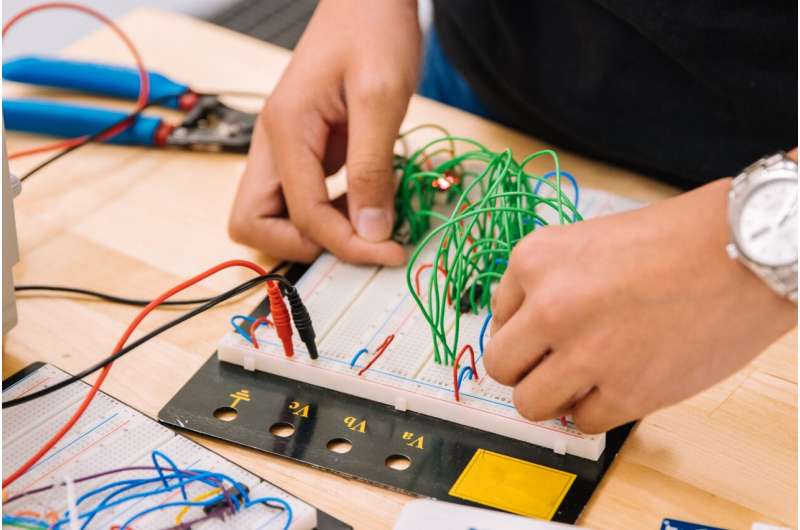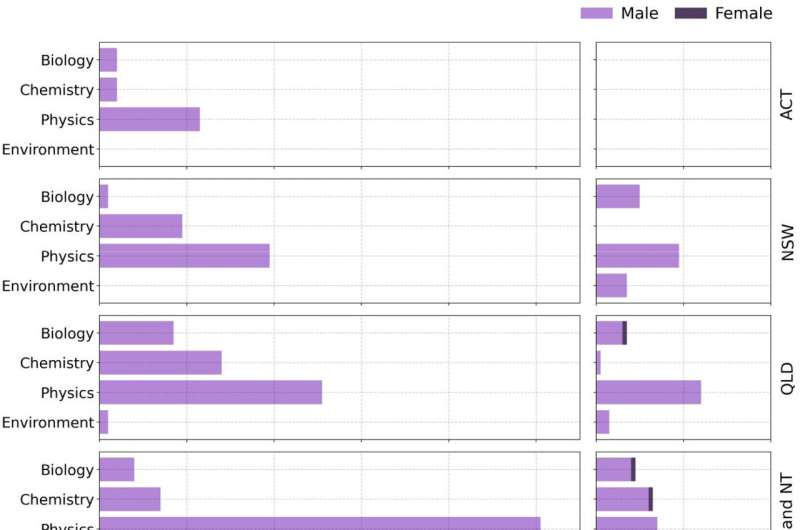This article has been reviewed according to Science X's editorial process and policies. Editors have highlighted the following attributes while ensuring the content's credibility:
fact-checked
trusted source
proofread
Female science heroes missing from Australian high school curricula

Australian high school students enrolled in STEM subjects don't read or learn about nearly as many prominent female scientists compared to their male counterparts, according to new research from Curtin University and The Australian National University (ANU).
The study shows school science lessons fail to mention the contributions of women in STEM and instead focus almost exclusively on a male-centric narrative. It found only three states or territories mentioned the work of a female science leader in their school curricula.
According to the authors, only one female scientist, British chemist Rosalind Franklin, was named in coursework in Queensland, South Australia and the Northern Territory. All other states and territories exclusively referenced the contributions of male scientists. This work was conducted as part of the IncludeHer movement, an initiative founded by Dr. Kat Ross in 2018 that aims to increase the number of women and gender minorities in STEM fields. It is published in the Australian Journal of Education.
Lead researcher Dr. Ross from Curtin University said the lack of female representation in science curriculums across the country was both alarming and inaccurate.
"This focus on a sole male genius is common throughout the Australian national syllabus, and we could only find one unique female scientist mentioned," Dr. Ross said.
"We know participation rates of girls in STEM are low compared to boys, and this gender gap in the science heroes they learn about at school is likely a contributing factor."

Study co-author Dr. Andrew Battisti from ANU said it is vital for female students to have role models to look up to in order to spur their interest in the sciences.
"Seeing role models in STEM fields that align with a student's identity can help to provide positive reinforcement that they themselves belong in STEM," Dr. Battisti said.
"In fact, my own choice to become an astronomer was strongly influenced by a high school science teacher fascinated by astronomy, whom I saw as a role model."
ANU Ph.D. researcher Tegan Clark said the imbalance of gender representation in Australian classrooms must be urgently addressed to ensure Australia's future as an aspiring STEM powerhouse.
"Off the back of our findings, the Queensland Curriculum Assessment Authority (QCAA) has taken positive steps to address the gender representation of scientists in the current senior science syllabuses," Clark said.
"The QCAA have since released drafts versions of new senior science syllabuses which now include meaningful mentions of scientists who are women, striking a better balance in gender representation, as well as providing modern examples of science."
The study also found an almost exclusive focus on European discoveries and research in STEM fields. The authors argue this could negatively impact students from culturally and linguistically diverse communities and contribute to lower levels of self-confidence and belonging.
"For children to develop a positive sense of identity and belonging, it's important for them to have access to accurate and authentic role models related to their gender and cultural backgrounds throughout their lives," Dr. Ross said.
The study analyzed the curriculum of four year 11 and year 12 STEM subjects taught in Australian schools—biology, chemistry, physics and environmental science.
More information: Kathryn Ross et al, Invisible women: Gender representation in high school science courses across Australia, Australian Journal of Education (2023). DOI: 10.1177/00049441231197245
Provided by Australian National University



















